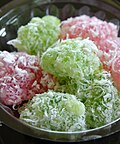Rice flour: Difference between revisions
CSV import Tags: mobile edit mobile web edit |
CSV import |
||
| Line 31: | Line 31: | ||
{{Nutrition-stub}} | {{Nutrition-stub}} | ||
{{Agriculture-stub}} | {{Agriculture-stub}} | ||
<gallery> | |||
File:Two_kinds_of_rice_flour.jpg|Two kinds of rice flour | |||
File:Rice_flour_2.jpg|Rice flour 2 | |||
File:1097Foods_Bread_Cuisine_of_Bulacan_01.jpg|Bread Cuisine of Bulacan | |||
File:Mitarashi_dango_by_yomi955_in_Kyoto.jpg|Mitarashi dango | |||
File:Jian_dui_in_London_(Chinatown).jpg|Jian dui in London | |||
File:Khanom_tom.JPG|Khanom tom | |||
File:Nepali_Sel_Roti_and_Khabjey.JPG|Nepali Sel Roti and Khabjey | |||
File:Naan_Berenji_16.jpg|Naan Berenji | |||
File:Cheret,_Jules_-_La_Diaphane_(pl_121).jpg|La Diaphane | |||
</gallery> | |||
Latest revision as of 21:22, 20 February 2025
Rice flour is a form of flour made from finely milled rice. It is a staple ingredient in many cultures and is used in a variety of culinary applications, including baking, thickening sauces, and making noodles. Rice flour is particularly important in gluten-free diets, as it serves as a substitute for wheat flour for individuals with celiac disease or gluten intolerance.
Types of Rice Flour[edit]
There are primarily two types of rice flour: white rice flour and brown rice flour. White rice flour is made from white rice and has a mild flavor, making it suitable for a wide range of dishes. Brown rice flour, made from brown rice, retains the bran and germ, offering a nuttier flavor and higher nutritional content, including fiber.
Specialty Rice Flours[edit]
In addition to the basic types, there are also specialty rice flours, such as sweet rice flour (also known as glutinous rice flour or mochiko) and black rice flour. Sweet rice flour is made from sticky rice and is commonly used in Asian desserts and snacks. Black rice flour, made from black rice, is rich in antioxidants and has a deep purple color, adding a unique hue to dishes.
Culinary Uses[edit]
Rice flour can be used in a variety of culinary applications. It is a popular ingredient in Asian cuisine, used in making noodles, dumplings, and traditional sweets. In Western cuisine, rice flour is often used in gluten-free baking, serving as a substitute for wheat flour in bread, cakes, and cookies. It is also used as a thickening agent in soups and sauces.
Nutritional Profile[edit]
Rice flour is a good source of carbohydrates and provides a small amount of protein. Brown rice flour is higher in fiber compared to white rice flour due to the presence of the bran and germ. However, rice flour is generally low in vitamins and minerals, and those on a gluten-free diet are encouraged to ensure they receive a balanced intake of nutrients from other sources.
Health Considerations[edit]
For individuals with celiac disease or gluten intolerance, rice flour offers a safe alternative to wheat flour. However, it is important to note that rice flour lacks certain nutrients found in wheat flour, such as fiber and B vitamins, unless it is fortified. Additionally, rice flour has a high glycemic index, which may affect blood sugar levels.
Production[edit]
Rice flour is produced by milling rice grains into a fine powder. The process involves cleaning, soaking, grinding, and drying the rice. The quality of rice flour can vary depending on the type of rice used and the milling process.
Environmental Impact[edit]
The production of rice flour has an environmental impact, primarily related to the cultivation of rice. Rice cultivation requires a significant amount of water, and in some cases, the use of pesticides and fertilizers. Sustainable farming practices and organic rice varieties can help mitigate these environmental concerns.
Conclusion[edit]
Rice flour is a versatile and essential ingredient in both traditional and gluten-free cooking. Its various types and uses make it a staple in kitchens around the world. While it offers benefits for those with gluten-related disorders, it is important to consider its nutritional profile and environmental impact.

This article is a agriculture stub. You can help WikiMD by expanding it!
-
Two kinds of rice flour
-
Rice flour 2
-
Bread Cuisine of Bulacan
-
Mitarashi dango
-
Jian dui in London
-
Khanom tom
-
Nepali Sel Roti and Khabjey
-
Naan Berenji
-
La Diaphane









